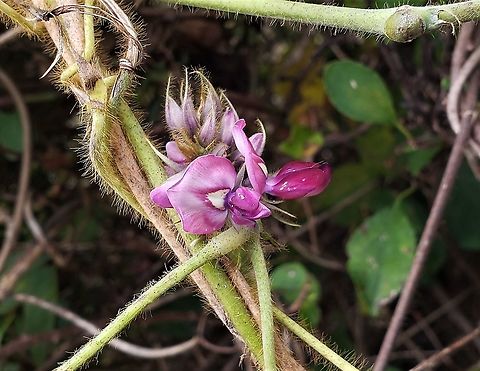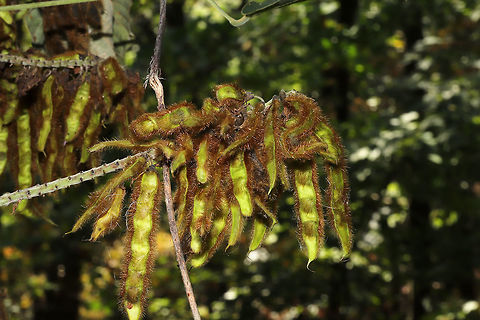
Appearance
It is an seasonal climbing plant, growing high where suitable surfaces are available, and also growing as ground cover where there are no vertical surfaces. It is a perennial vine with tuberous roots and rope-like, dark brown stems to 20 m long. It grow up to 20 m per year and can achieve a growth height of 30 m. It has markedly hairy herbaceous stems.''Pueraria montana'' is native to Southeast Asia, primarily subtropical and temperate regions of China, Japan, and Korea, with trifoliate leaves composed of three leaflets. Each leaflet is large and ovate with two to three lobes each and hair on the underside. The leaves have the ability to fix atmospheric nitrogen, which can supply up to 95% of leaf nitrogen to the plant in poor soils. Along the vines are nodes, points at which stems or tendrils can propagate to increase support and attach to structures. As a twining vine, kudzu uses stems or tendrils that can extend from any node on the vine to attach to and climb most surfaces. In addition, the nodes of the kudzu vine have the ability to root when exposed to soil, further anchoring the vine to the ground. The roots are tuberous and are high in starch and water content, and the twining of the plant allows for less carbon concentration in the construction of woody stems and greater concentration in roots, which aids root growth. The roots can account for up to 40% of total plant biomass.
Flowers are reddish-purple and yellow, fragrant, similar to pea flowers, about 20–25 millimetres wide and are produced at the leaf axis in elongated racemes about 20 centimetres long. The flowering period extends from July through October. The fruit is a flat hairy pod about 8 centimetres long with three seeds.

Distribution
The natural range of ''Pueraria montana'' in east Asia, is the India, Myanmar, Indochina, China, Korea and Japan to Thailand, Malaysia, the Pacific Islands and north Australia. In its native habitat, it and closely related species occur across wide areas; the species have diverged genetically due to vicariance.Like other exotic species, the introduction to other areas is due to human actions. Seeds are spread by mammals and birds. Kudzu are plants adapted to the drought. Only aboveground portions are damaged by frost; thick storage roots grow as deep as 1 metre. It forms new perennial root crowns from stem nodes touching the ground.
The ecological requirements of the species are those of the subtropical and temperate habitat areas.
In Europe, ''Pueraria montana'' grows in several places in warm regions of Switzerland and Italy near Lake Maggiore and Lake Lugano.
During World War II, kudzu was introduced to Vanuatu and Fiji by United States Armed Forces to serve as camouflage for equipment. It is now a major weed there.
''Pueraria montana'' is also becoming a problem in northeastern Australia.
In the United States, ''Pueraria montana'' is extensively reported in Alabama, Arkansas, Connecticut, Washington, D.C., Delaware, Florida, Georgia, Illinois, Indiana, Kentucky, Maryland, Missouri, Mississippi, North Carolina, North Dakota, New Jersey, Oregon, Ohio, Pennsylvania, South Carolina, Tennessee, Texas, Virginia, and West Virginia. Of these states, three in the southeast have the heaviest infestations: Georgia, Alabama, and Mississippi.

Reproduction
Kudzu’s primary method of reproduction is asexual vegetative spread which is aided by the ability to root wherever a stem is exposed to soil. For sexual reproduction, kudzu is entirely dependent on pollinators.References:
Some text fragments are auto parsed from Wikipedia.